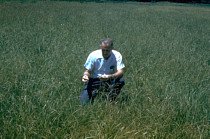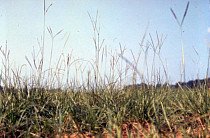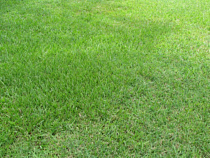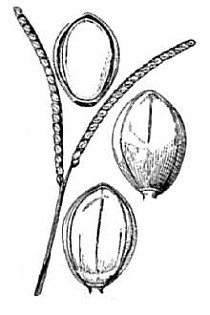Low Maintenance Turfgrass
Bahia grass is a warm-season perennial that is native to South America. It was introduced in 1913 to Florida as a forage grass. Also known as Highway grass in the South where it is planted extensively along roadsides for erosion control. A tough, drought-tolerant grass that is cheap and easy to grow making it a good choice for low-maintenance lawns, utility turfs, pastures or in wildlife habitats.
These characteristics that make it ideal for erosion control along highways also allow Bahia to become invasive and weedy. It often becomes a weed in neglected lawns.
Adapted to warm tropical and warm subtropical climates. It grows best on sunny sites with sandy, infertile soils that are slightly acidic.
Bahia does not make a high-quality lawn grass. Its open growth habit leaves it exposed to weed invasion. It also produces a lot of ugly seedheads that don’t cut cleanly when mowed. Argentine is the best variety to plant in low-maintenance lawns.
Characteristics
- Warm Season perennial turfgrass
- Deep-rooted and spreads by stolons and rhizomes
- Rhizomes and stolons have a woody appearance
- Very coarse textured grass
- Used in lawns, roadsides, pastures and wildlife habitats
- Likes sandy, infertile soils that are slightly acidic
- Drought tolerant
- Prefers full sun and has a low shade tolerance
- Distinctive Y-shaped seedheads
- The ugly seedheads are formed late spring through fall
- Very few insect or disease problems
- Not shade or cold-tolerant
- Takes a beating and withstands heavy traffic
Planting

Plant Bahia seed or sod in late spring through mid-summer – giving the grass enough time to mature before winter. The seed is cheap and is the easiest way to start a Bahia lawn – sod if you want an instant lawn. Argentine Bahiagrass is the best variety to use in lawns.
Mowing

Recommended mowing height is between 2 ½ to 4 inches. Sharp lawn mower blades are needed to cut the tough, fibrous leaf blades and seed heads. It does not grow very tall, most cuttings are needed to remove the ugly seed heads. Mow every 5 to 7 days.
Watering

Drought tolerant, but it will show signs of stress and go dormant during dry spells. Responds quickly to rain by greening up. Supplement rainfall by watering ¾ to 1 inch – once a week – when it starts to show signs of stress from lack of water. Be sure to water deep – 8 inches into the soil to encourage strong rooting.
Fertilizing

USDA-NRCS PLANTS Database / Hitchcock, A.S. (rev. A. Chase). 1950. Manual of the grasses of the United States. USDA Miscellaneous Publication No. 200. Washington, DC.
A maximum of 2 lbs of nitrogen per year is split into 2 to 4 applications from green-up in the spring through early fall.
Pests
Mole crickets are the only pest that can be a problem.
Bahia Grass Varieties
Argentine is the only really good choice for lawns. It has a nice green color and does not produce as many ugly seedheads as the other varieties. Argentine makes a decent low-maintenance lawn.
Pensacola is widely used on roadsides and in pastures. It has a strong and deep root system making it drought-tolerant and good for erosion control.
Tifton 9 is an improved selection of Pensacola used in pastures and for erosion control.
More Grass Types
Buffalo Grass Lawns Buchloe dactyloides
A warm-season perennial grass that is a good choice for low-maintenance landscapes. Buffalo grass is the only native grass species widely used in lawns.
Bermuda Grass Lawn Care, Types, Planting and Maintenance
What is Bermuda grass? Hybrid vs. Common, uses and the best types for home lawns. How to plant and care for a Bermudagrass lawn. Helpful DIY tips and advice for planting and growing grass.
Is Zoysia grass perfect for home lawns? It’s beautiful when properly maintained. If you are lucky enough to live in a climate suitable for growing warm-season grasses, zoysia might be the best choice.
